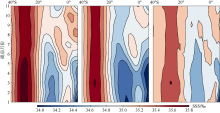| [1] |
方长芳, 张翔, 尹建平, 2013. 21世纪初海洋预报系统发展现状和趋势[J]. 海洋预报, 30(4): 93-102.
|
|
FANG CHANGFANG, ZHANG XIANG, YIN JIANPING, 2013. Development status and trends of ocean forecasting system in the 21st Century[J]. Marine Forecasts, 30(4): 93-102. (in Chinese with English abstract)
|
| [2] |
李雁领, 俞永强, 张学洪, 等, 2004. 热带太平洋和印度洋海面高度季节循环和年际变化的数值模拟[J]. 大气科学, 28(4): 493-509.
|
|
LI YANLING, YU YONGQIANG, ZHANG XUEHONG, et al, 2004. Numerical simulation of seasonal cycle and interannual variation of sea surface height in the Tropical Pacific and Indian Oceans[J]. Chinese Journal of Atmospheric Science, 28(4): 493-509. (in Chinese with English abstract)
|
| [3] |
刘凯, 孙照渤, 杜岩, 2011. 基于INSTANT数据对ITF流出海峡海流的功率谱分析[J]. 热带海洋学报, 30(6): 1-9.
doi: 10.11978/j.issn.1009-5470.2011.06.001
|
|
LIU KAI, SUN ZHAOBO, DU YAN, 2011. Power spectrum analysis of Indonesian Throughflow based on INSTANT data[J]. Journal of Tropical Oceanography, 30(6): 1-9. (in Chinese with English abstract)
doi: 10.11978/j.issn.1009-5470.2011.06.001
|
| [4] |
王辉赞, 张韧, 2012. 基于Argo资料和混合层模式的淡水通量产品重构[J]. 物理学报, 61(3): 039202.
|
|
WANG HUIZAN, ZHANG REN, 2012. Freshwater flux product reconstruction based on Argo data and mixed layer model[J]. Acta Physica Sinica, 61(3): 039202. (in Chinese with English abstract)
doi: 10.7498/aps.61.039202
|
| [5] |
王健, 杜岩, 郑少军, 等, 2014. 2004-2011年印度尼西亚贯穿流在望加锡海峡中的年际变化[J]. 热带海洋学报, 33(6): 9-16.
doi: 10.11978/j.issn.1009-5470.2014.06.002
|
|
WANG JIAN, DU YAN, ZHENG SHAOJUN, et al, 2014. Interannual variability of Indonesian throughflow in the Makassar Strait during 2004-2011[J]. Journal of Tropical Oceanography, 33(6): 9-16. (in Chinese with English abstract)
doi: 10.11978/j.issn.1009-5470.2014.06.002
|
| [6] |
晏红明, 肖子牛, 2000. 印度洋海温异常对亚洲季风区天气气候影响的数值模拟研究[J]. 热带气象学报, 16(1): 18-27.
|
|
YAN HONGMING, XIAO ZINIU, 2000. The numerical simulation of the Indian Ocean SSTA influence on climatic variations over Asian monsoon region[J]. Journal of Tropical Meteorology, 16(1): 18-27. (in Chinese with English abstract)
|
| [7] |
CHEN DAKE, YUAN XIAOJUN, 2004. A Markov model for seasonal forecast of Antarctic sea ice[J]. Journal of Climate, 17(16): 3156-3168.
doi: 10.1175/1520-0442(2004)017<3156:AMMFSF>2.0.CO;2
|
| [8] |
DONLON C J, MARTIN M, STARK J, et al, 2012. The Operational sea surface temperature and sea ice analysis (OSTIA) system[J]. Remote Sensing of Environment, 116: 140-158.
doi: 10.1016/j.rse.2010.10.017
|
| [9] |
FOLTZ G R, GRODSKY S A, CARTON J A, et al, 2004. Seasonal salt budget of the northwestern tropical Atlantic Ocean along 38°W[J]. Journal of Geophysical Research: Oceans, 109(C3): C03052.
|
| [10] |
GUAN LEI, KAWAMURA H, 2003. SST availabilities of satellite infrared and microwave measurements[J]. Journal of Oceanography, 59(2): 201-209.
doi: 10.1023/A:1025543305658
|
| [11] |
GUO YUFU, WANG JIA, ZHAO YAN, 2004. Numerical simulation of the 1999 Yangtze river valley heavy rainfall including sensitivity experiments with different SSTA[J]. Advances in Atmospheric Sciences, 21(1): 23-33.
doi: 10.1007/BF02915677
|
| [12] |
JOHNSON S D, BATTISTI D S, SARACHIK E S, 2000. Empirically derived Markov models and prediction of tropical pacific sea surface temperature Anomalies[J]. Journal of Climate, 13(1): 3-17.
doi: 10.1175/1520-0442(2000)013<0003:EDMMAP>2.0.CO;2
|
| [13] |
LIN CHUANLAN, SU JILAN, XU BINGRONG, et al, 2001. Long-term variations of temperature and salinity of the Bohai Sea and their influence on its ecosystem[J]. Progress in Oceanography, 49(1-4): 7-19.
doi: 10.1016/S0079-6611(01)00013-1
|
| [14] |
QIU YUN, CAI WENJU, et al, 2012. Argo profiles variability of barrier layer in the tropical Indian Ocean and its relationship with the Indian Ocean Dipole[J]. Geophysical Research Letters, 39(8): L08605.
|
| [15] |
REYNOLDS R W, SMITH T M, LIU CHUNYING, et al, 2007. Daily High-Resolution-Blended analyses for sea surface temperature[J]. Journal of Climate, 20(22): 5473-5496.
doi: 10.1175/2007JCLI1824.1
|
| [16] |
SAJI N H, GOSWAMI B N, VINAYACHANDRAN P N, et al, 1999. A dipole mode in the tropical Indian Ocean[J]. Nature, 401(6751): 360-363.
|
| [17] |
SRIVASTAVA A K, RAY K C S, 2000. Assessing peak warming of SST over equatorial eastern Pacific Ocean: (Niño 3 Region) with the help of circulation pattern over India during El Niño events[J]. Journal of the Meteorological Society of Japan, 78(3): 279-288.
|
| [18] |
THIÉBAUX J, ROGERS E, WANG WANQIU, et al, 2003. A New High-Resolution blended real-time global sea surface temperature analysis[J]. Bulletin of the American Meteorological Society, 84(5): 645-656.
doi: 10.1175/BAMS-84-5-645
|
| [19] |
WOODRUFF S D, WORLEY S J, LUBKER S J, et al, 2011. ICOADS Release 2.5: Extensions and enhancements to the surface marine meteorological archive[J]. International Journal of Climatology, 31(7): 951-967.
doi: 10.1002/joc.2103
|
| [20] |
WU QIAOYAN, YAN YING, CHEN DAKE, 2013. A linear Markov model for east Asian monsoon seasonal forecast[J]. Journal of Climate, 26(14): 5183-5195.
doi: 10.1175/JCLI-D-12-00408.1
|
| [21] |
XUE YAN, CANE M A, ZEBIAK S E, et al, 1994. On the prediction of ENSO: A study with a low-order Markov model[J]. Tellus A, 46(4): 512-528.
doi: 10.3402/tellusa.v46i4.15641
|
| [22] |
ZHAN RUIFEN, WANG YUQING, LEI XIAOTU, 2011. Contributions of ENSO and east Indian Ocean SSTA to the interannual variability of northwest Pacific tropical cyclone frequency[J]. Journal of Climate, 24(2): 509-521.
doi: 10.1175/2010JCLI3808.1
|
 ), GONG Yuanfa1, WANG Guihua4(
), GONG Yuanfa1, WANG Guihua4( )
)





















